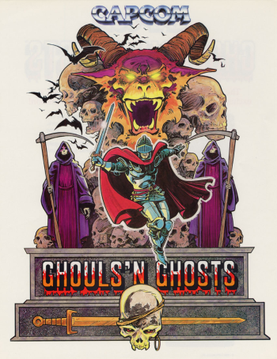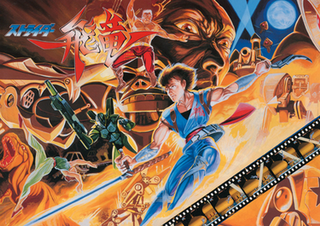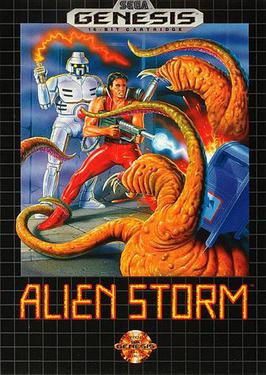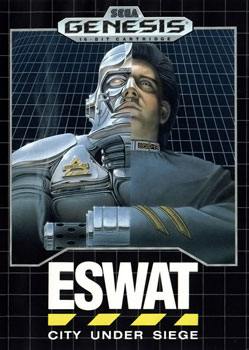
Ghouls 'n Ghosts, known as Dai Makaimura in Japan, is a side-scrolling platform game developed by Capcom, released as an arcade video game in 1988 and ported to home platforms. It is the sequel to Ghosts 'n Goblins and the second game in the Ghosts 'n Goblins series.

Columns is a match-three puzzle video game released by Sega in 1990. Designed by Jay Geertsen, it was released by Sega for arcades and then ported to several Sega consoles. The game was subsequently ported to home computer platforms, including the Atari ST.

Shinobi (忍) is a side-scrolling hack and slash video game produced by Sega, originally released for arcades on the Sega System 16 board in 1987. The player controls ninja Joe Musashi, to stop the Zeed terrorist organization from kidnapping students of his clan.

Wonder Boy in Monster Land, known by its original arcade release as Wonder Boy: Monster Land, is a platform video game developed by Westone Bit Entertainment and released by Sega in Japanese arcades in 1987 and for the Master System in 1988, with a number of other home computer and console ports following. The game is the sequel to the 1986 game Wonder Boy and takes place eleven years after the events in the previous game. After enjoying over a decade of peace on Wonder Land following the defeat of the evil King by Tom-Tom, later bestowed the title "Wonder Boy", a fire-breathing dragon called the MEKA dragon appeared; he and his minions conquered Wonder Land, turning it into "Monster Land". The people, helpless due to their lack of fighting skill, call for Wonder Boy, now a teenager, to destroy the monsters and defeat the MEKA dragon. Players control Wonder Boy through twelve linear levels as he makes his way through Monster Land to find and defeat the MEKA dragon. Players earn gold by defeating enemies and buy weapons, armor, footwear, magic, and other items to help along the way.

Altered Beast is a 1988 beat 'em up arcade video game developed and published by Sega. The game is set in Ancient Greece and follows a player character chosen by Zeus to rescue his daughter Athena from the demonic ruler of the underworld, Neff. Through the use of power-ups, the player character can assume the form of different magical beasts. It was ported to several home video game consoles and home computers. It was the pack-in game for the Mega Drive when that system launched in 1988.

Moonwalker is a 1988 American experimental anthology musical film starring Michael Jackson. Rather than featuring one continuous narrative, the film expresses the influence of fandom and innocence through a collection of short films about Jackson, several of which are long-form music videos from Jackson's 1987 album Bad. The film is named after the dance technique known as the moonwalk, which Jackson was known for performing.

Strider, released in Japan as Strider Hiryū, is a hack-and-slash platform game released in arcades in 1989 by Capcom. Set in a dystopian future where Earth is ruled by the tyrannical Grandmaster Meio, it follows the titular Strider named Hiryu as he attempts to end his tyrannical reign for good. The game resulted from cooperation between Capcom and manga publisher Moto Kikaku. It marked the video game debut of Strider Hiryu, after the character was introduced in the 1988 manga Strider Hiryu.

Golden Axe is a side-scrolling hack-and-slash video game released by Sega for arcades in 1989, running on the Sega System 16B arcade hardware. Makoto Uchida was the lead designer of the game, and was also responsible for the creation of the previous year's Altered Beast. The game casts players as one of three warriors who must free the fantastical land of Yuria from the tyrannical rule of Death Adder, who wields the titular Golden Axe.

The Revenge of Shinobi, released in Japan as The Super Shinobi, is a hack-and-slash action video game developed and published by Sega in 1989. It was the first Shinobi game developed for the Sega Genesis, and was later released on the coin-operated version of that console, the Mega-Tech.

Bonanza Bros. is a 3D-style, 2D side-scrolling stealth action game developed and released by Sega in 1990. It is one of the earliest arcade games powered by the Sega System 24 arcade system board. It was ported to various home systems, including the Mega Drive/Genesis, Master System, PC-Engine/TurboGrafx-CD, and several home computers.

Castle of Illusion Starring Mickey Mouse is a 1990 platform game developed and published by Sega and released for the Mega Drive/Genesis. An 8-bit version of the game was later released for the Master System and Game Gear. The game follows Mickey Mouse on a quest to save Minnie Mouse from the evil witch Mizrabel. It is the first game in Sega's Illusion video game series starring Mickey.

Alien Storm (エイリアンストーム) is a beat 'em up shooter released as an arcade video game by Sega in 1990. It was ported to the Genesis/Mega Drive and Master System. The Mega Drive version was re-released on Wii's Virtual Console in 2007 and was also included on Sonic's Ultimate Genesis Collection for Xbox 360 and PlayStation 3. The game was also re-released on the Nintendo Switch Online + Expansion Pack in 2022.

Mercs, originally released as Senjō no Ōkami II in Japan, is a run and gun video game developed and published in arcades by Capcom in 1990. It is a sequel to the 1985 arcade video game Commando. While not as successful as its predecessor, Mercs was well received by critics and was a moderate commercial success. It was followed by Wolf of the Battlefield: Commando 3 in 2008, a downloadable game.

Shadow Dancer is a side-scrolling hack-and-slash action game produced by Sega and originally released as an arcade game in 1989. It is the second and the final arcade game in the Shinobi series, following the original Shinobi itself. The player controls a ninja aided by an attack dog, who is fighting to save the city from a terrorist organization.

Shadow Dancer: The Secret of Shinobi, also known simply as Shadow Dancer, is a side-scrolling action game developed and published by Sega for the Sega Genesis in 1990. It is the second game in the Shinobi series released for the Mega Drive, following The Revenge of Shinobi. However, it is not a continuation of the previous game, but rather a loose adaptation of the 1989 arcade game Shadow Dancer. Like in the original arcade game, the player controls a ninja followed by a canine companion. The Secret of Shinobi was well received by critics.

Golden Axe II is a side-scrolling beat 'em up video game developed and published by Sega, first released on the Sega Mega Drive in December 1991. It is the home console sequel to the popular game Golden Axe, marking the second game in the series, though the arcade did see a sequel of its own in 1992, titled Golden Axe: The Revenge of Death Adder. Golden Axe II was only released on the Mega Drive, while the original was released on many other platforms. The game later appeared in Sonic's Ultimate Genesis Collection for Xbox 360 and PlayStation 3, as an iOS app on iTunes, and on the Nintendo Switch Online + Expansion Pack.

ESWAT: City Under Siege, released in Japan as Cyber Police ESWAT, is a 1990 side scrolling action platform video game developed and published by Sega for the Sega Genesis and Sega Master System video game consoles.

Super Monaco GP is a Formula One racing simulation video game released by Sega, originally as a Sega X Board arcade game in 1989, followed by ports for multiple video game consoles and home computers in the early 1990s. It is the sequel to the 1979 arcade game Monaco GP. The arcade game consists of one race, the Monaco Grand Prix, but later ports added more courses and game modes based on the 1989 Formula One World Championship.

Galaxy Force is a rail shooter video game developed and released by Sega for arcades in 1988. The player assumes control of a starship named the TRY-Z, as it must prevent the Fourth Empire from taking over the entire galaxy. Gameplay involves shooting down enemies using either a laser shot or a limited supply of heat-seeking missiles, all while avoiding collision with projectiles or obstacles and making sure the ship's energy meter doesn't fully deplete. It ran on the Sega Y Board arcade system, and was released with a motion simulator cockpit arcade cabinet version like previous Sega Super Scaler games.
There are at least nine video games that Michael Jackson has composed music for or are directly related to him. Sega was the developer for at least six of them: the arcade and Mega Drive/Genesis versions of Michael Jackson's Moonwalker, Michael Jackson in Scramble Training for arcades, Sonic the Hedgehog 3 for the Mega Drive/Genesis, and Space Channel 5 and Space Channel 5: Part 2 for the Dreamcast. The other three were produced by other companies: Moonwalker for home computers by U.S. Gold, Michael Jackson: The Experience by Ubisoft, and Planet Michael by SEE Virtual Worlds.




















